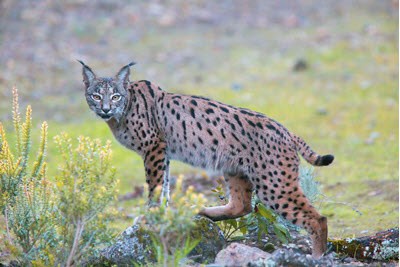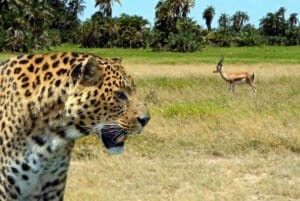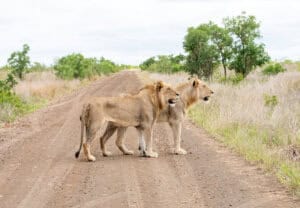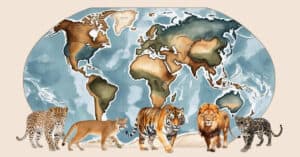The Iberian lynx (Lynx pardinus) is an endangered wild cat found on the Iberian Peninsula. Through special conservation programs, including reintroduction, the species population has been increasing.


Scientific Name: Lynx pardinus
Conservation Status: Endangered
Population: Approximatley 2,000 individuals as of 2024
Lineage: The Iberian lynx belongs to the Lynx lineage, along with the Canada lynx, bobcat, and European lynx.
Interesting Iberian lynx facts
- Will bury their prey and return later to finish eating it
- Between 2012 and 2023, the population has increased from 326 to over 2,000
- Its scientific name was first proposed in 1827.
- Closest relative is the Eurasian lynx.
- Became a unique species between .7 and 2 million years ago.
- Has tufted ears
- Females with kittens require more nutrition (3 rabbits a day) than males (1 rabbit a day).
- Rabbits are 75% of its prey.
Iberian Peninsula
The Iberian Peninsula is located in south-western Europe. It is also known as Iberia and includes Spain, Portugal, Andorra, Gibraltar, and a small part of France. The population is estimated at 53 million.
The terrain of the Iberian Peninsula is primarily mountainous, with three main climates: oceanic (marine climate), Mediterranean (dry summer climate), and steppe climates (a type of dry climate).
The Iberian Peninsula has woodlands that are unique ecosystems. The Iberian lynx is considered a symbol of these forests and animal life of the entire Peninsula.

More about the Iberian lynx
Physical Characteristics
The Iberian lynx’s fur ranges from tawny to yellow. Its coat is spotted and short. The cat also has a short body and tail but long legs. The head of the Iberian lynx is relatively small, with tufted ears and long whiskers.
| Iberian lynx | FROM | TO |
| Weight | 15 lbs. | 35 lbs. |
| Body length | 29.4 in. | 32.3 in. |
| Tail length | 4.9 in. | 6.3 in. |
Females are smaller than males. They typically range from 27 – 31 inches in length, and weigh 20 -22 lbs.
Location and Habitat
The Iberian lynx has lost more than 80% of its range. By the 1990s, only two small populations lived on the peninsula, one in Montes de Toledo and the other in Sierra Morena. The cat is typically found in grasslands and areas with dense shrubs.
Hunting and Prey (Diet)
Iberian lynx primarily feeds on rabbits but can also eat rodents, partridge, deer, mouflon (wild sheep), and ducks. A lynx will stalk its prey and wait behind rocks and bushes before pouncing. The lynx competes for prey with the Iberian wolf, red fox and Egyptian mongoose.
Reproduction and Lifespan
The gestation period is approximately 60 days, and kittens are born between March and September. Litters consist of one to three kittens who become independent at around 7 to 10 months old. However, they will stay with their mother until almost two years of age. Due to the small size of the population, there is frequent inbreeding.
Conservation Threats
Aggressive conservation and reintroduction programs have been implemented to prevent the extinction of the Iberian lynx. Projects include restoring the cat’s native habitat, captive breeding and release, and rabbit population management. The cat is fully protected and can no longer be hunted.

Iberian Lynx Research Quotes
2010 Iberian lynx: the uncertain future of a critically endangered cat | Ferreras, Rodriguez, Palomares, Delibes. “The Iberian lynx (Lynx pardinus) is at risk of being the first member of the Felidae to go extinct since the last glaciation.”
2012 First captive-bred individuals released in the Iberian lynx reintroduction programme | Simon, Boixader, et al. “As part of the first Iberian lynx reintroduction
programme, two captive-born individuals were released in the wild in the 2010-2011 season for the first time with this species. The development of both individuals in the wild was good, as they showed natural feeding and social behaviours.”


















0 Comments